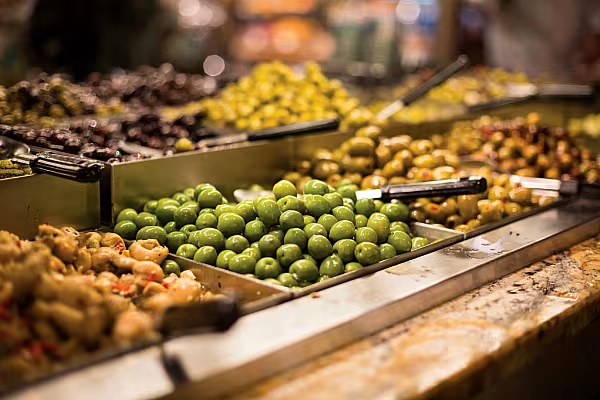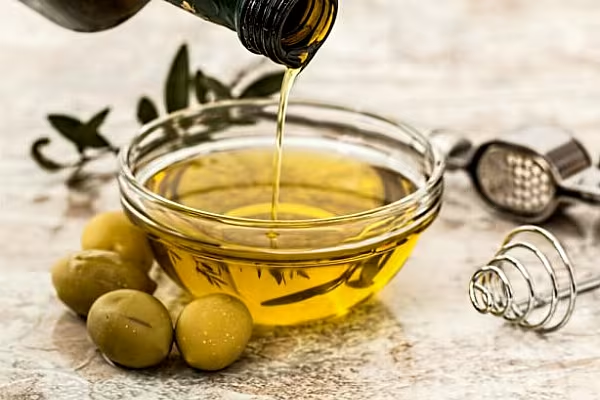Dayeeta Das examines the latest developments in the table olives and olive oil sectors, and explores whether the segment is turning bearish. This article first appeared in ESM’s July/August 2024 edition.
Olive oil – an essential ingredient in the Mediterranean diet and known for its numerous health benefits – has been grabbing headlines in the past couple of years because of exponential price increases.
The year began with news of olive oil prices increasing by 50%, in January 2024, compared to the same period in the previous year. The preceding months were no different, with year-on-year prices increasing significantly between August 2023 and January 2024 – peaking in November, at 51% – compared to the same period in the previous year, according to data from Eurostat.
As the year progressed, data showed that the price of extra-virgin olive oil (EVOO) in Spain, Italy and Greece – the harvests of which were completed in April 2024 – increased, on average, by 31%, 35% and 39%, respectively, to reach record highs in the 2023/24 season. This is a significant development because Spain, Italy and Greece account for 60% of global olive oil production, and as top producers in the European Union, prices in these three countries, particularly in Spain, impact other producing countries – specifically, the oils that they intend to export.
Meanwhile, global olive oil prices have been falling from their mid-January peaks, but still remain higher than those quoted two years ago.
Nick Peksa, managing director of Cost Insights, tells ESM, “Prices are gradually decreasing as the next season approaches, in October, when increased production will help balance supply and demand.”
This potential respite from ever-increasing prices is backed by a positive outlook for upcoming campaigns, as Silvan Brun, founder of EVOO ag, notes.
“Things are looking quite promising in Andalusia, for example, as far as the coming harvest campaign is concerned,” Brun says. “As Andalusia is the largest producing region in the world, this should actually have an influence on the price,” however, he cautions that prices are still comparatively high, and there are no real signs of a decline.
Agroindustry analyst and CEO of Vilcon, Juan Vilar, adds that a potential challenge for the sector is to “adapt demand to supply quickly and efficiently,” to ensure that a high drop in prices does not occur.
Beyond Climate Change
Many recent developments around olive oil – from pricing and production to harvest and availability – point to the impact of climate change on the sector. In the recent past, unpredictable weather has heavily impacted the production of several crops globally, and olive plantations were no exception.
“Without a doubt, climate is the most influential factor in production,” says Vilar.
Adverse weather conditions lead to reduced production, which, in turn, raises prices – ultimately lowering consumption.
Conversely, when weather conditions improve, production increases, causing prices to drop. While several seasons of extreme droughts have affected production in major Mediterranean countries, as well as in other producing nations, Brun believes that climate change is an insufficient explanation for skyrocketing prices.
“For better or worse, we have to live with the risk of dramatic weather events,” he says. “It is important to distinguish whether these weather events are actually natural, or whether they are the result of deliberate weather modification. To this end, it is advisable to read through the numerous patents on weather manipulation in order to understand that it is not always due to climate change.”
While climate-related price adjustments are a part of the equation, Brun highlights that, in the past, prices – especially in Spain – have never risen as drastically as they have over the last 18 months. This is backed by data on previous low-yielding harvests. In the past 12 years, there were five harvest periods with low yields, and prices did not rise as steeply in the first four low-yielding campaigns as they did in the latest.
“We can therefore assume that this is a political manoeuvre designed to increase the value of Spanish olive oil to catch up with that of Italy,” says Brun, who adds that there is no logical reason why Italian olive oil should be more expensive than its Spanish equivalent – “Neither is inherently better,” he notes – as there is no difference in the quality of the oils.
Consumption And Consumer Prices
Consumption of olive oil in the EU dropped by around a fifth in the last marketing year, and it is expected to decline further in 2023/24, as it will take time before producer prices are transferred to consumers, according to the short-term outlook for olive oil by the European Commission.
Consumer prices of olive oil across Europe have increased by 52% this year. In Greece, olive oil consumption has declined by up to 40%, with consumers replacing the oil with alternatives like sunflower oil.
A study by the National Bank of Greece showed that olive oil prices drove half of the country’s inflation in April of this year. Consumption in both main producing countries and the rest of the EU could drop by an additional 3% and reach the historical minimum – below 1.2 million tonnes, data has shown. In Spain, the consumption of extra-virgin olive oil fell by 23.8% in 2023, according to a report by Mercacei, prompting the Spanish government to completely abolish VAT on olive oil from the start of July of this year, to stabilise its consumption.
The German-speaking DACH region, which has a population of around 100 million, is also witnessing a decline in consumption.
Adds Brun, “This is also because the prices of olive oil and seed oils are moving in opposite directions. This emphasises the major problem that this industry has – it always produces far more than consumers can consume. It would be wise for the industry to realise that it would be of great economic benefit to produce higher-quality olive oil, but less.”
According to Vilar, consumption trends are also influencing this shift, with the consumer profile for olive oil an increasingly older demographic, generally those over the age of 50.
“The younger generation consumes more food prepared outside the home – either by restaurants, or by the processing industry – and these companies fundamentally make their products with other fats,” he says.
Production And Harvests
Global olive oil production in 2023/24 is expected to be below average, declining by 2%, compared to the previous year. This decline is attributed to a significant drop in production in non-EU countries, expected to be 14% below the five-year average.
“Lower-than-expected harvests in Algeria, Israel, Lebanon, Morocco, Palestine and Türkiye, along with anticipated poor harvests in leading Southern Hemisphere exporters – Argentina, Chile and Peru – have further complicated the situation by limiting supply for bottlers, and some nations, fearing domestic shortages, curbed their bulk exports,” Cost Insights’ Peksa notes.
A below-average production total also awaits the EU, with the five-year average down by almost a quarter (-24%). The EU has increased its olive oil imports from non-EU countries, compared to the previous year. Key non-EU exporters to the bloc include Syria, Morocco, Türkiye and Tunisia. Imports into the EU rose by 28.8% in the first half of 2023/24.
The overall availability of olive oil in the EU is expected to decrease, based on the ending stocks for the current marketing year, Peksa adds.
“There should be enough olive oil to meet demand ahead of the next harvest, with an estimated 120,000 tonnes in Spain and 260,000 tonnes globally by the end of 2023/24,” he says. “Most olive oil consumption in the Northern Hemisphere occurs at home. A shortage of extra-virgin olive oil is likely, but virgin olive oil stocks should last until the early harvest, in October.”
Elsewhere, Vilar is optimistic that there may not be a shortage, after all, as the temporary decline in consumption in the past two years was motivated by consumers shifting to slightly lower categories of oil, or smaller formats, to suit their budgets.
Table Olives
Global table olive production has declined by 12%, year on year, in the 2023/24 season, to a projected 2.659 million tonnes – from 3.019 million tonnes in the previous season. In the EU, this figure is 29% lower than the five-year average, with Greece seeing a decline of 66% and Spain remaining stable.
The market price of raw olives allocated for table olive production increased in this period – by 36.6% in Spain, by 78.2% in Greece, and by 80.2% in Portugal. As a result of this increase in prices, US imports of Spanish table olives have been at their lowest level for the last decade.
As Vilar notes, “Normally, of the total fruit produced on the planet, between 8% and 13% is allocated to the production of table olives. However, in these last two campaigns, this has not happened, and farmers have allocated almost 100% of the fruit to the production of olive oils, due to high prices.
“With the change in cycle, we will return to a balance similar to what occurred in the past – approximately 12% of the fruit is destined for table olives, and the rest for the production of oil.”
Market Outlook
The outlook for the 2024/25 campaign is optimistic, with projected output reaching 3.0 million tonnes. Early reports from new harvests are encouraging, with robust fruit blossoming and water reserves higher than usual for this time of the year. Moreover, to date, there have been no significant events that would prevent analysts from making this optimistic estimation.
A strong harvest from Spain is likely to bolster global supply, but it is also important to monitor weather patterns closely, as unexpected climatic shifts could still impact the overall yield.
“The variables that we need to take into account when looking to the future are natural weather, manipulated weather, political manoeuvring, and geopolitical scenarios, such as the conflict between Russia and Ukraine,” says Brun, who dismisses concerns that climate change could lead to the decline of the olive sector in Europe in the near future.
“At some point, it will no longer be possible to grow olives in Southern Europe – that is certain,” he explains. “But to understand this, we need to have an understanding of the great cycles of nature, and so we can say that olive oil from Southern Europe will continue to be available for us and future generations.”














